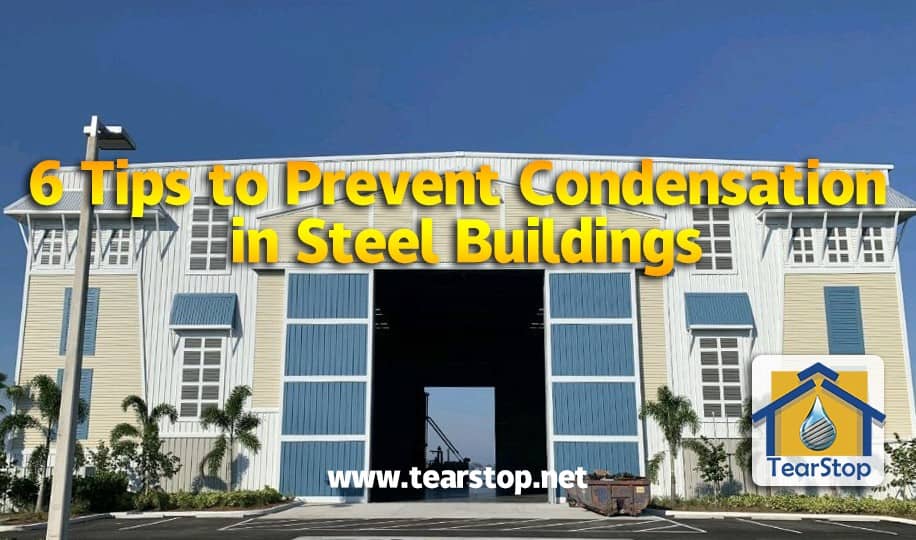
While metal buildings are safe from rot and termites, they can still suffer harm from excessive moisture. Damp insulation is less effective at regulating temperatures in a steel building. This may promote mold or mildew growth, making the building interior smell musty and potentially contributing to allergy problems. Also, wet insulation in constant contact with metal surfaces can cause corrosion-even for surface-treated metals. The panels and fasteners may begin to rust, leading to premature failure of these materials.
Why Does Condensation Occur in Metal Buildings?
Understanding how and why condensation occurs in steel structures is the first step in preventing this problem. Two factors must be present for condensation to form. First, the air must be moist. The higher the humidity in the air, the greater the chances of condensation. Ideally, a metal building interior should have a humidity level between 30-50%. Higher levels of humidity make condensation much more likely. The second factor is the temperature difference between the surface and the surrounding air. Warm air can hold more moisture than cold air. A metal mini-storage building in a chilly climate where temps fall into the 30s for extended periods will have very cold walls. When warm, moist air inside the building hits the cold surface, it becomes chilled and deposits condensation on the metal.
This means there are a couple of ways to prevent condensation in steel buildings:
- Ensure the air inside the building isn’t coming into direct contact with the cold metal walls and roof.
- Reduce the humidity in the building interior with adequate ventilation and other measures.
Here are five ways to accomplish these objectives.
#1 Use Proper, Continuous Insulation
Insulation that regulates the temperature inside a building helps reduce condensation. First, it keeps the interior temperature from fluctuating as much between day and night, limiting the amount of “dew” deposited on surfaces overnight. Second, it prevents warm, moisture-laden air from reaching the metal surfaces on the building’s interior. So, for insulation to work effectively, it needs to be continuous. Placing it only between the metal studs means water vapor can still accumulate between the panels and seep into the insulation.
#2 Install Vapor Barriers
A vapor barrier is also necessary to protect the building from condensation. This barrier helps to keep moisture from the outside from penetrating the building. Again, properly sealing the building envelope is what helps keep moisture to a minimum. Many vapor barriers are also designed to serve as radiant heat barriers, addressing the temperature differential and humidity simultaneously. Windows, doors, foundation sills, and side/end laps need thorough sealing to keep moisture out.
#3 Ventilate the Interior
There are many reasons moisture might occur inside a metal structure, increasing the humidity. For example, in agricultural buildings, livestock gives off a lot of moisture as they breathe, sweat, and eliminate. Gas or oil-based heaters can also raise the humidity in a building. Encouraging air exchange between the interior and exterior helps keep things dry. You can do this by opening a window, running a fan or AC compressor, or installing screened vents or louvers on the walls/roof. Heaters should vent to the outside of the building. Also, dehumidifiers might help in some situations, but they are costly and require good drainage.
#4 Look for Condensation Troubles Up Above
If the insulation on the roof’s underside is sagging and not in full contact with the metal, this is a great place for hidden condensation to accumulate and cause trouble. Roof leaks or moisture seeping through penetrations can cause a lot of moisture to build up in the ceiling insulation over time. This type of problem can occur when flashing is missing, incorrectly installed, or damaged.
#5 Prevent Water Seeping from Below
In regions where moisture can seep up from the ground, having gravel, crushed rock, or other drainage materials under the concrete slab can help limit condensation around the structure’s base. Roof runoff and other sources of water should be drained away from the foundation as well. A vapor retarder can also be placed between a subfloor and the ground slab.
It’s possible to retrofit insulation and ventilation into an existing metal building, but it’s easier to design things right from the start to limit or prevent condensation in steel buildings. So, to begin the design process, contact our team today.
#6 Use Tearstop Anti condensation felt
Tearstop has become the world’s best-selling condensation control product by being faster.more cost effective and more durable.
Arrives at the job site already on the street.Saves you Money-Saves you Time.
No more labor costs for installing insulation.It completely cuts out one step of the building process.and up to half the time on the roof.

